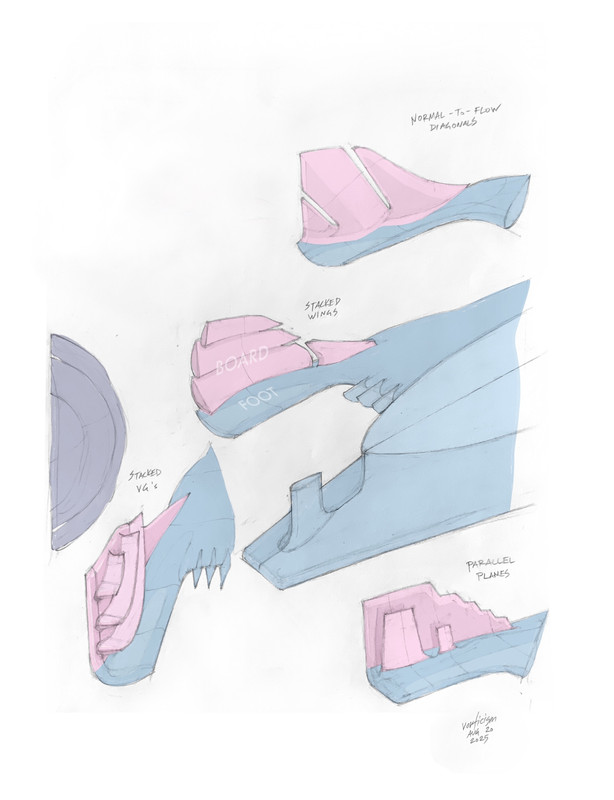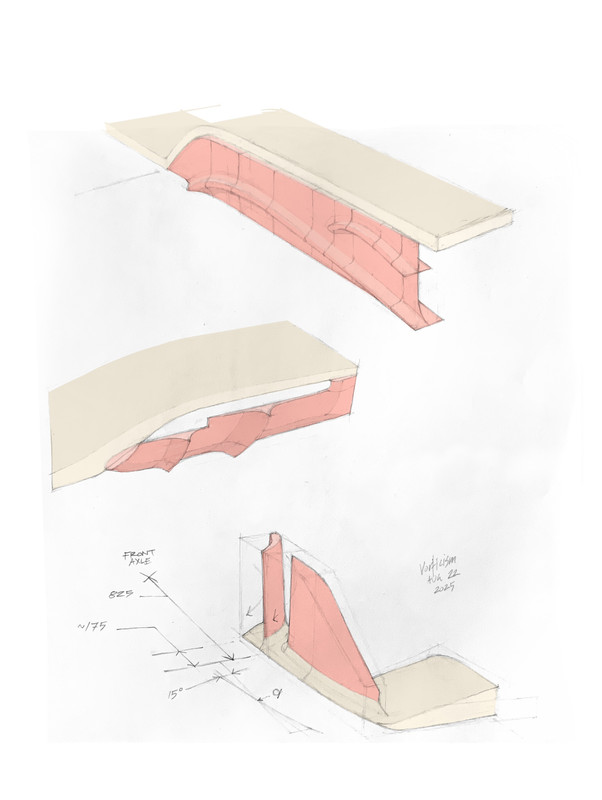- Login or Register
No account yet? Sign up

Sounds like a exam. What do you want to tell us?jjn9128 wrote: ↑19 Aug 2025, 11:38Right... and a diffuser isn't ground effect? How does it "kill" a tunnel underbody but not a flat underbody? What are the mechanism differences? You still create low pressure under the car, you still need to seal the floor edge ingress, you still need to prevent tyre wake coming into the floor. So what mechanisms are at play that you so confidently say "rake = more downforce" for a flat floor car?
Red Bull were one of the first to run high rake and it is not about achieving higher downforce. From my article about how diffusers work you will see that you can get more stable diffuser performance over a reasonable range of heights with more expansion. But that is not why RB went for high rake. All teams tested higher rake in their wind tunnels and saw no gains in downforce. What you gain is reduced aero balance change with speed. Normally a car would increase aero balance if you push both front and rear heights down in parallel. With more rake, you can run softer rear springs. A low speed the rear is very high but the rules force all parts to be aligned around the floor planes. That means high rake will push the front wing down into ground effect. More front downforce at low speed. At high speed the rear is pushed down much more than the front which reduces rake on everything (lowers drag) and also pushes the front wing up relative to the height at the front wheels (because the rear moves so much). Red Bull are not the car with the most rake any more. All barge teams have barge boards and vortex generators on the floor with this level of complexity.
This.
And this.karana wrote: ↑19 Aug 2025, 18:45Here is what Willem Toet wrote in a comment under his article "How motorsport diffusers work" on Linkedin 5 years ago:
Red Bull were one of the first to run high rake and it is not about achieving higher downforce. From my article about how diffusers work you will see that you can get more stable diffuser performance over a reasonable range of heights with more expansion. But that is not why RB went for high rake. All teams tested higher rake in their wind tunnels and saw no gains in downforce. What you gain is reduced aero balance change with speed. Normally a car would increase aero balance if you push both front and rear heights down in parallel. With more rake, you can run softer rear springs. A low speed the rear is very high but the rules force all parts to be aligned around the floor planes. That means high rake will push the front wing down into ground effect. More front downforce at low speed. At high speed the rear is pushed down much more than the front which reduces rake on everything (lowers drag) and also pushes the front wing up relative to the height at the front wheels (because the rear moves so much). Red Bull are not the car with the most rake any more. All barge teams have barge boards and vortex generators on the floor with this level of complexity.
Clarification on this: if the RW has 2 elements, the rearmost element (the flap) is to be used for the RWAS just like the current DRS actuation. If the RW has 3 elements, both of the rearmost elements are considered as flaps and must move together as the RWAS.vorticism wrote: ↑14 Aug 2025, 18:24Per issue 13:
-There are front wing and rear wing versions of the adjuster system (FWAS & RWAS).
-FW: up to 3 profiles, one or two of the rearmost of which can comprise the FWAS.
-RW: up to 3 profiles, the rearmost of which can comprise the RWAS.
-If using 2 profiles in the FWAS they can rotate along their own axis, with a max deviation of 30 mm for the “Primary Flap” and 60mm for the “Secondary Flap.”
-FWAS flap pivot axis can be angled up to 30 deg from transverse, meaing (I take it) there can be one continuous flap with a 0* axis (like current RW DRS) or one flap per side with up to a 30* axis (like current FW flaps)
-FWAS can have one or two actuators, one centrally with a fairing, or one per side faired with the FW pylons, and be driven electrically (new) or hydraulically
-Two positions like DRS: “corner mode” and “straight-line mode” with a maximum 400 ms transition time.
-There will still be “activation zones” defined by the FIA similar to the current DRS zones--presumably comprising any applicable corners and straights per track.
All told I see one major potential differentiation available across teams: a FWAS that has either one, two, or four rotating flaps. Another less visible one will be the choice to use a hydraulic piston or an electromechanical actuator.
Free as in easily accessible. Never claimed the Merc W series cars were low DF; what made you read this?
The 2022 concept was effectively a skirted tunnel with a prescribed location for the venturi neck, what some call the kick. Recall the first year spec had the floor edges at the same height as the reference plane--about as close as they could get to full contact skirts. Cleverly RB took that one step further with what I at the time coined their ice skates i.e. their interpretation of the edge wing allowance, which they used not as a wing but as a metal strake beneath the floor edge that did somewhat act like an actual skirt and as a stop. The prescribed location of the neck/throat of the venturi was in a region just ahead of the fronts of the rear tyres i.e. pretty far back, nearer to the rear axle than the center of the car. Rake angle would have proportionally lifted that point off the ground and would have compromised the skirt seal and reduced the pressure ratio the tunnel could achieve.
I'm not saying anything, in the end it will be the result of a given teams car philosophy. All I'm asking for is some critical thinking as to why rake is used on an f1 car - the mechanisms at play, the fact the best teams at raking their car pre-22 had quite flexible bibs and planks to really make it work, the fact that floor (and other parts of the car) optimization was different between the high and low rake concepts. Then consider what it is about the 26 regs which will mean rake is desirable? What is the desired flowfield aim of each concept and how might that be achieved on a 26 car?
Rake can increase the effect of the diffuser, but only if you're able to seal the diffuser from rear tire squirt effectively enough, according to this article, the new inward flowing bargeboards makes tire wake difficult to control, so I don't expect high rake designs, not in the beginning of these regulations anywayjjn9128 wrote: ↑20 Aug 2025, 10:08I'm not saying anything, in the end it will be the result of a given teams car philosophy. All I'm asking for is some critical thinking as to why rake is used on an f1 car - the mechanisms at play, the fact the best teams at raking their car pre-22 had quite flexible bibs and planks to really make it work, the fact that floor (and other parts of the car) optimization was different between the high and low rake concepts. Then consider what it is about the 26 regs which will mean rake is desirable? What is the desired flowfield aim of each concept and how might that be achieved on a 26 car?
Then consider why statements like the below are so incredibly inaccurate. Why is moving your diffuser kick (the region of greatest suction on the floor) out of ground effect "free floor downforce"? Why is it that you think flat floor = must have rake?



Well, who calls you incredibly inaccurate matters. If Willem logs in to castigate me, my ears will perk up. I explained what I meant by free yet it went unquoted. Downforce from rake is not strictly a matter of the diffuser and its distance to the ground, in this case, the average range of static height variation of ~50mm (half a rain light--useful dimension!) at the rear of the cars apparent when comparing pre-'22 cars f.e. 2019 RB/Sauber/Ferrari/Mclaren/Renault vs Merc, in other words, the choice of avg ~3* of rake vs ~1.5* across the season.jjn9128 wrote: ↑20 Aug 2025, 10:08I'm not saying anything, in the end it will be the result of a given teams car philosophy. All I'm asking for is some critical thinking as to why rake is used on an f1 car - the mechanisms at play, the fact the best teams at raking their car pre-22 had quite flexible bibs and planks to really make it work, the fact that floor (and other parts of the car) optimization was different between the high and low rake concepts. Then consider what it is about the 26 regs which will mean rake is desirable? What is the desired flowfield aim of each concept and how might that be achieved on a 26 car?
Then consider why statements like the below are so incredibly inaccurate. Why is moving your diffuser kick (the region of greatest suction on the floor) out of ground effect "free floor downforce"? Why is it that you think flat floor = must have rake?
Part of the '26 concept must have this in mind, owing to where they chose to place this new, major aero implement. I see it as adding a high pressure field above the front floor corner. If the wake is a problem though, it makes me think we might see teams try to make these things more outwashing by various means f.e. a small forward portion of the bargeboard ("floor board") could be situated in opposition to the majority of it. Lower item below.

Upper two items in the sketch above. The diffuser strakes must fit inside a straight box (see linked post), although it's 40mm wide. 1 x, 2 y, 1 z, leaves only a few development paths.